Shut out from talks on Colorado River crisis, tribes want inclusion and ‘transformation’
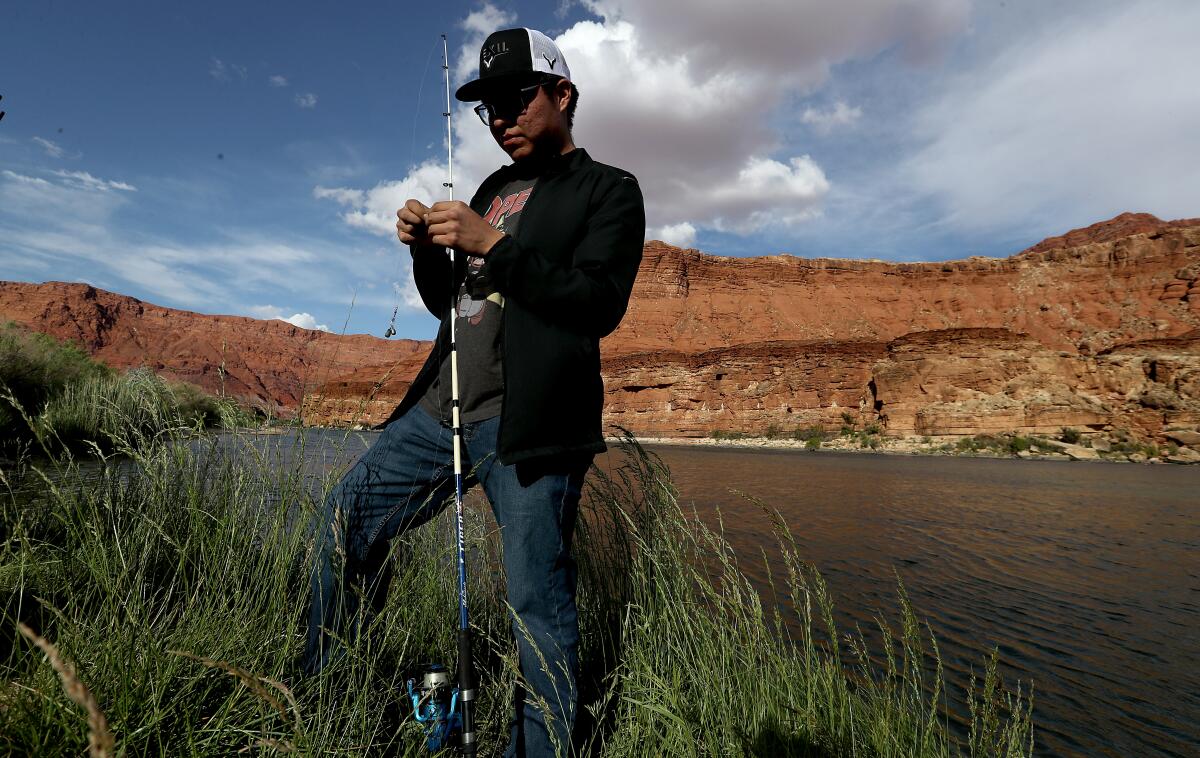
This is the July 21, 2022, edition of Boiling Point, a weekly newsletter about climate change and the environment in California and the American West. Sign up here to get it in your inbox.
Good morning. I’m Ian James, water reporter for The Times, filling in for Sammy Roth, who will be back next week.
It’s crunch time for the Colorado River. The river’s badly depleted reservoirs keep dropping, and the federal government has announced that major water cutbacks need to happen soon to prevent supplies from reaching perilously low levels.
The future of the Southwest’s main water lifeline hinges on whether the seven states of the Colorado River Basin will effectively address the river’s chronic overuse and shrinking flows after more than two decades of drought intensified by global warming. The major players include public officials representing agencies that supply water to farmlands and cities from Denver to Los Angeles.
There are also 30 federally recognized tribes in the Colorado River Basin, and I’ve been interested in learning more about the roles they will play in shaping how dwindling supplies water are apportioned and conserved.
There is a long history of keeping Native tribes out of discussions about the river, and one the most passionate critics of this exclusion is Daryl Vigil, the water administrator for the Jicarilla Apache Nation in New Mexico. For years, he has been a leading voice in pushing for tribes’ inclusion in Colorado River talks and advocating for solutions on reservations where many still lack access to clean drinking water.
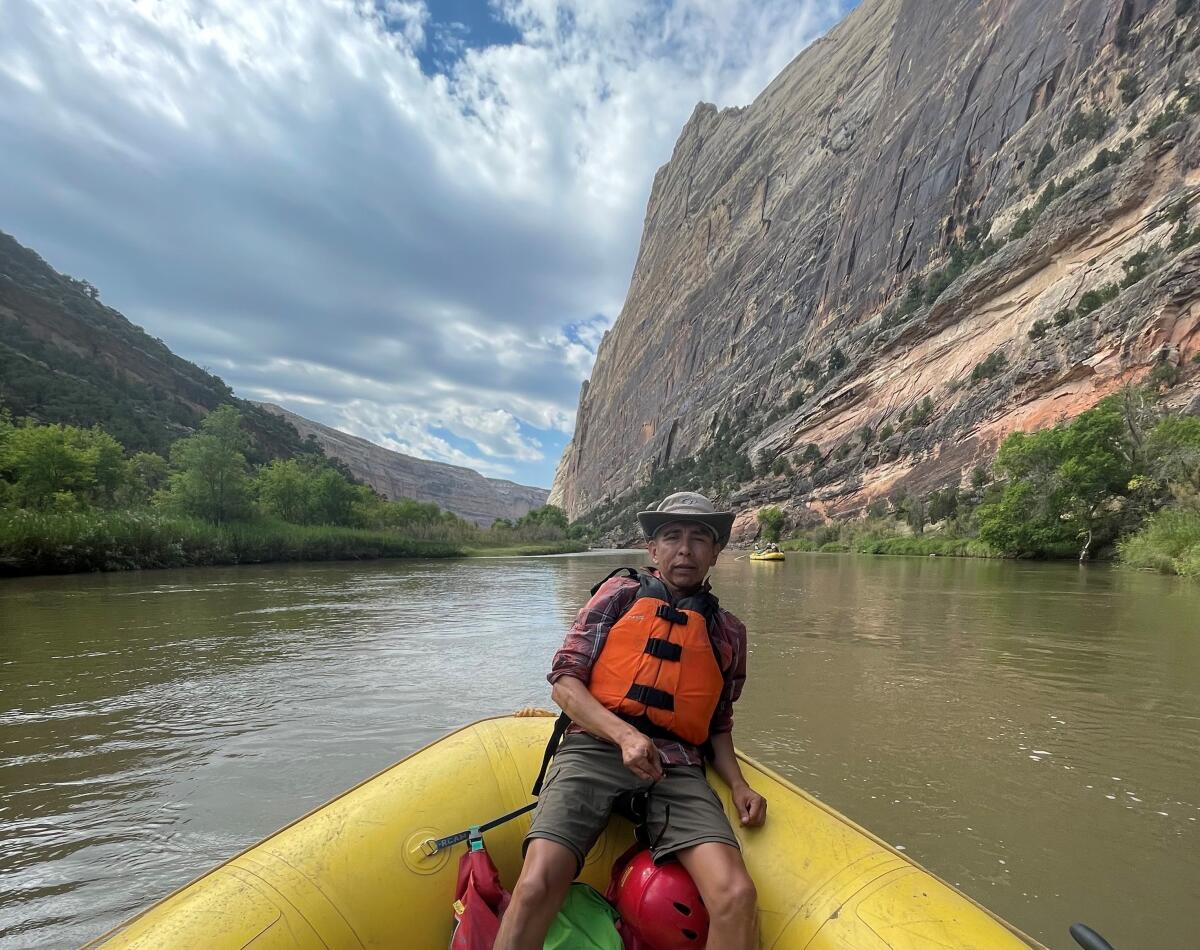
“We were never a part of this conversation to begin with,” Vigil said during a recent conference at the University of Colorado Law School in Boulder. He pointed out that the original 1922 Colorado River Compact includes a section stating that nothing in the pact “shall be construed as affecting the obligations of the United States of America to Indian tribes.”
“That’s the foundational law of the river. It says it doesn’t apply to us,” Vigil said.
Tribal nations have established rights to roughly one-fourth of the river’s average supply. Twelve of the tribes also still have unresolved water rights claims.
On many reservations, people continue to struggle with serious water infrastructure deficiencies. In the Navajo Nation, an estimated 30% or more of people live in homes without running water. Some members of the Hopi Tribe have no running water, and many others have water contaminated with toxic arsenic.
Vigil has stressed that tribes “need to be at the decision-making table.” He said one major problem was the lack of an established structure for tribal involvement in Colorado River issues. He said this exclusion “just has to stop.”
“In 2022, we don’t have any ability to participate in the policy conversation because there’s nowhere to do that,” Vigil said. He said that only recently had tribal leaders begun to be more involved, and “this is something that needs to be built collectively.”
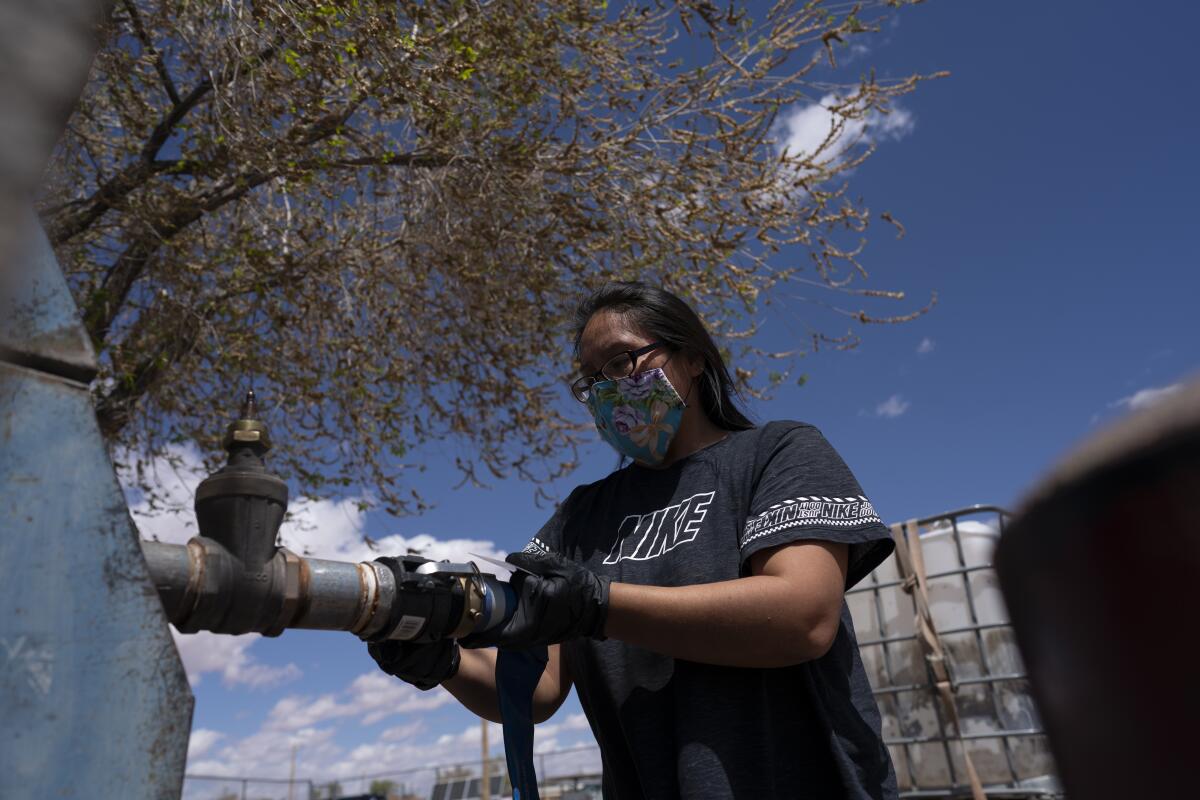
“When we talk about equity and inclusion, absolutely, for me, it’s based in a recognition of tribal sovereignty and self-determination,” he said. “It’s really great to talk about, you know, things are getting better. But we need transformation.”
I called Vigil, who serves as co-facilitator of the Water & Tribes Initiative, to ask him about what sort of transformation he thinks is needed. My interview with Vigil has been edited for clarity and brevity.
ME: You talked about how for decades tribal leaders have been largely excluded from discussions about the river. What do you think needs to change?
VIGIL: First and foremost, it’s the federal government’s trust responsibility to create a place for the 30 tribal sovereigns to engage in the policymaking process. A letter to Interior Secretary Deb Haaland last November was endorsed by 20 tribes in the basin, which is historic. That prompted a meeting with the secretary in Albuquerque on March 28, and that letter lays out specific tribal asks, or demands. And at the top of that list is this fulfillment of trust responsibility for engagement in the policymaking process and in terms of fulfilling settlement promises of infrastructure and federal dollars, and then fulfillment on things like basic human rights in terms of universal access to clean water. Tribes have been waiting for the federal government to deliver on infrastructure promises, in some cases for decades.
ME: You and other tribal leaders have emphasized the importance of equity and inclusion in the Colorado River Basin. What do you think that will require?
VIGIL: We need that place that recognizes our tribal sovereignty to engage in the policymaking process. There’s something called the sovereign review team that was put in place in the Columbia River Basin. I’ve been saying, let’s create a structure like that in the Colorado River Basin, where we have the sovereigns (tribes, states, federal government and Mexico) involved in the processes, and we don’t have to re-create the wheel. It’s been suggested that we call it the sovereign governance team. The federal government and the basin states are both aware — because we’ve made them aware — of our historic exclusion. With ownership to 25% of the river, 3.4 million acre-feet, it’s absolutely unconscionable why there’s not a place for us at the policy table. It doesn’t make any sense.
This is a situation where we really have an opportunity to define collectively what equity is, and especially with this life-giving resource, and the need to look at it in terms of a healthy, living, sustainable river.
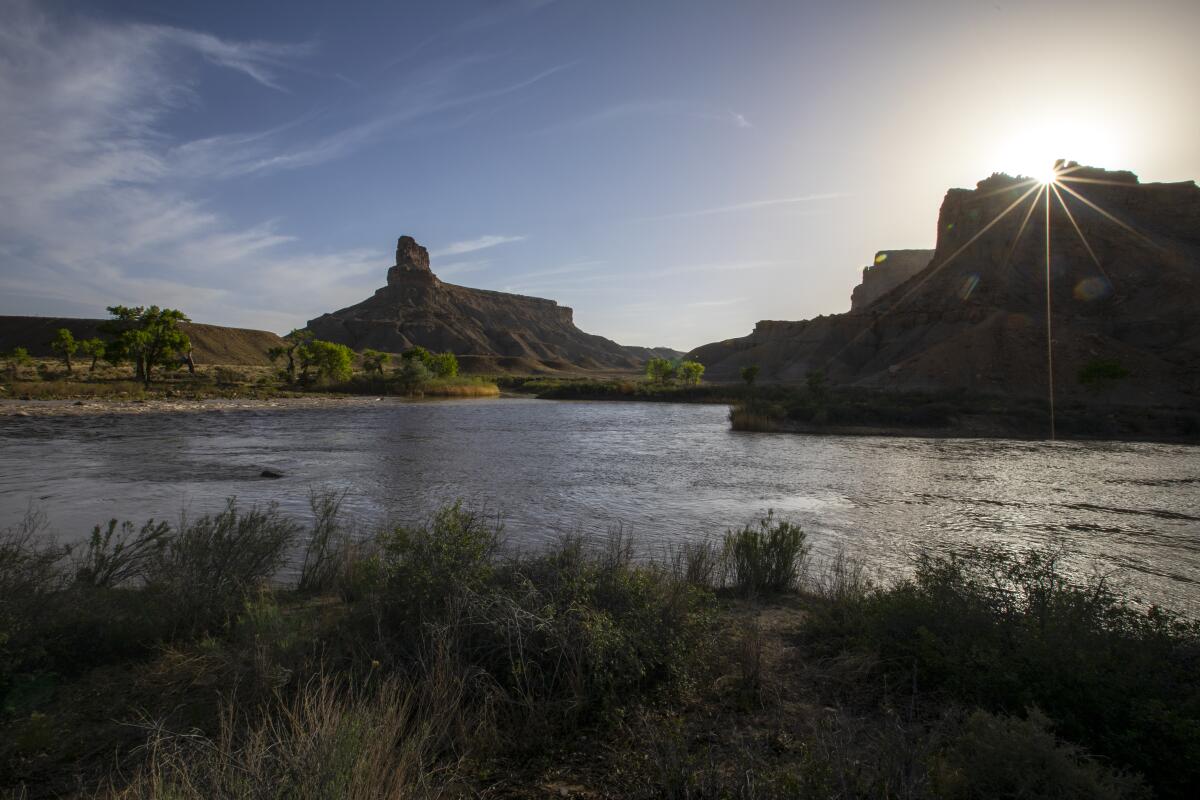
ME: You’ve said that, on the Colorado River, tribal water rights continue to be a “gray area.” How would you explain that?
VIGIL: There are a handful of tribes that haven’t settled and quantified their water rights with the federal government yet. And then there is a whole slew of tribes who haven’t been able to develop their water rights. What has happened as a result of not being able to develop water rights is that this water just flows down the river uncompensated, and for the Upper Basin (Colorado, Wyoming, Utah and New Mexico), that’s a huge issue. The Lower Basin (Nevada, Arizona and California), not so much. Those tribes that have larger quantities of water rights are participating in drought-contingency planning already, are actively in the mix of the policymaking process. The Upper Basin tribes absolutely are looking at ways to figure out how we can also be compensated for our unused, undeveloped water rights that are just going down to the Lower Basin.
ME: With the river in a shortage, how do you think the institutions that manage the river should answer the question of where water for future tribal settlements will come from?
VIGIL: I think we need to look at the 80-plus percent of the water usage in the basin that is agriculture. And that’s such a broad, broad area. When we start to look at the future, that’s a huge, huge elephant gray area in the room. There’s not a collective conversation that’s going on right now around 80% or more of the water in the basin, which is insane. So where are tribal water rights going to come from in the future for those who haven’t settled? The tribes that are asking are not seeking huge quantities. They just want some quantity for their reservations so that they can continue to live.
We’re all going to have to deal with less. That’s what this hydrology is forcing us to do. And so what does less usage look like from everybody, collectively? And until we have the federal government help us clear up these gray areas, it’s hard to really plan for the future.
ME: I remember you said at the conference, “There’s not a whole lot of mystery left in the Colorado River, except the human mystery about how we’re going to do this together.” What do you think the “human mystery” is?
VIGIL: When I talk about the human mystery, what I think about is that we prepared a document called “Toward a Sense of the Basin.” And we did 150 or so interviews, a cross-section of the basin. And one of the things that we heard almost unanimously was this value of a healthy, sustainable, living Colorado River. And so when we talk about the human factor, I’m talking about collective values. That’s the cool thing about this opportunity. We get to decide who we’re going to be as human beings in this basin into the future. But that can only happen if we clear up some of these gray areas.
There is a set amount of water that’s available to us. How do we start to have those conversations of equity and inclusion of those voices that haven’t been included before? And how can we do that as quickly and as efficiently as we can, given that the situation could worsen?
The one thing that definitely tribes fear is having to litigate. That’s my fear too, because if we get into litigation, I don’t know if that’s a death warrant for the river or not. But it’s not a good thing.
Here is our weekly look at what’s happening in California and around the West:
TOP STORIES
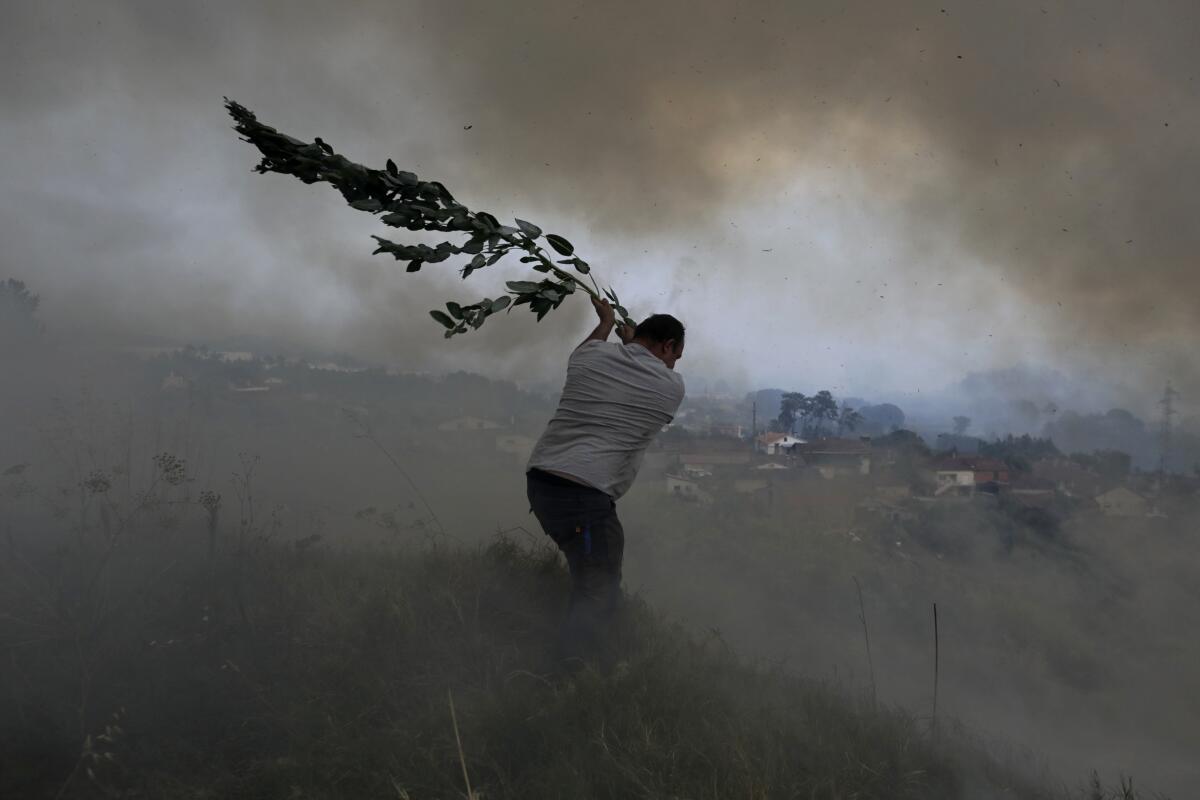
The news from Europe this week has shown how extreme heat waves and wildfires are intensifying and spreading with unbridled climate change. Britain broke a record for its highest temperature ever recorded, more than 104 degrees, which brought a sweltering struggle for many in a country where less than 5% of homes have air conditioning, as my colleague Jaweed Kaleem reported for The Times. One of Britain’s major airports, London Luton, briefly shut down as the runway buckled in the heat. As temperatures surged across Europe and wildfires raged, more than 1,900 heat-related deaths had been reported in Spain and Portugal by Wednesday, with hundreds more elsewhere.
Europe isn’t the only part of the world that is baking right now. Temperatures have also risen above 100 degrees across large portions of the U.S., nearing or setting records in states from Utah to Kansas to Montana, as Matthew Cappucci and Jason Samenow of the Washington Post explained in a story with a series of striking maps. They noted that another heat wave is ravaging central Asia. “In other words, three exceptional heat waves are affecting the Northern Hemisphere.” And as UCLA climate scientist Daniel Swain pointed out on Twitter, another heat wave is forecast to descend on the Pacific Northwest in late July and is expected to affect northern and inland areas of California.
While extreme heat engulfs much of the planet, Washington remains mired in legislative limbo after Democratic Sen. Joe Manchin III rejected his party’s promised reforms on climate change. Democratic members of Congress voiced their dismay, with some vowing to continue their push for action. Sen. Ed Markey of Massachusetts tweeted: “Rage keeps me from tears. Resolve keeps me from despair. We will not allow a future of climate disaster.” On Wednesday, President Biden announced new executive orders designed to bolster offshore wind energy programs and help communities adapt to extreme heat, The Times’ Courtney Subramanian and Eli Stokols reported. The president stopped short of declaring a national climate emergency but called the crisis “code red for humanity” and signaled that, in the absence of Senate action, further executive actions would be forthcoming.
WATER IN THE WEST
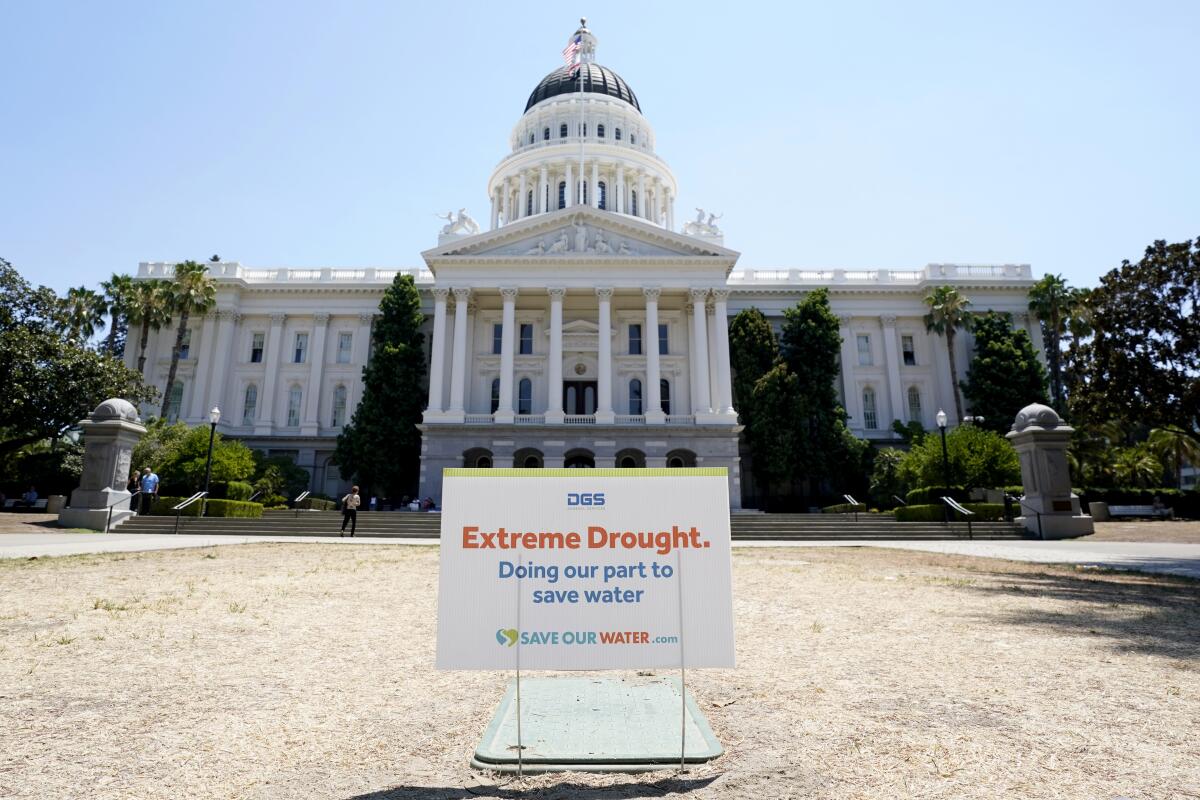
The Colorado River’s main reservoirs have fallen so low that Western states are under pressure to drastically cut water use. It’s a crisis that scientists have long warned was coming, but those warnings about climate change and chronic overuse of water largely went unheeded, as I reported Friday. I heard from one reader who said the piece reminded her of the film “Don’t Look Up” and its fictional story about astronomers who try unsuccessfully to sound alarms about a comet headed for Earth. Some scientists told me they see a parallel between the failure to heed scientists’ warnings about the Colorado River and inaction on the climate crisis. As scientist Brad Udall put it, “Humans are really reluctant to give things up to prevent a catastrophe. They’re willing to hang on to the very end and risk a calamity.”
With the changing climate intensifying drought and putting growing strains on water supplies, cities and water agencies in Southern California are investing heavily in wastewater recycling. My colleague Jaimie Ding wrote about large-scale water recycling initiatives that are under development in Los Angeles County, including a $3.4-billion plant in Carson and a plan of roughly $16 billion to treat and reuse wastewater at Los Angeles DWP’s Hyperion Water Reclamation Plant. Here and elsewhere in the state, there is big potential to recycle more wastewater. For now, about 23% of the state’s municipal wastewater is recycled.
California’s severe drought is expected to force farmers to leave a sizable portion of the state’s farmland unplanted this year due to major cuts in water supplies. As Kim Chipman reported for Bloomberg, a UC Merced researcher says about 800,000 acres of farmland could be dry and fallow this year, much more than last year. Karen Ross, secretary of the California Department of Food and Agriculture, shared that same preliminary acreage estimate earlier this month in an interview with The Times. Researchers have estimated that the drought last year caused California’s agriculture industry to shrink by about 8,700 jobs and shoulder $1.2 billion in direct costs as water cutbacks forced growers to leave cropland dry.
POLITICAL CLIMATE
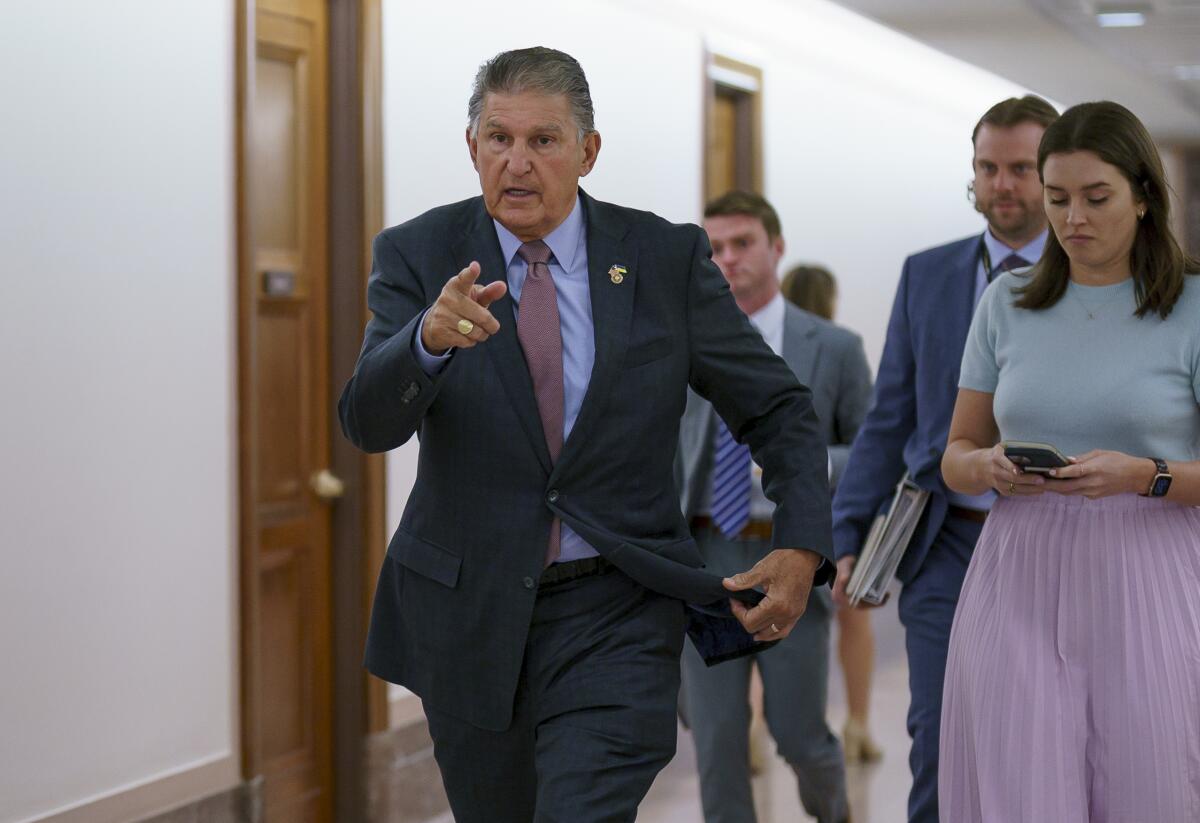
Returning to the latest events in Washington, Manchin’s decision not to support his party’s climate legislation is stirring outrage among climate advocates, who say now is the time for a renewed push for action. Leah Stokes, an associate professor of political science at UC Santa Barbara, wrote in a New York Times guest essay that the stakes of further delay could not be higher. “If more Democrats are elected this fall, especially to the Senate, we may find ourselves with a window for federal climate legislation next year,” Stokes wrote. “The climate crisis is getting worse, and Congress is one vote short of saving us. We’re going to have to save ourselves.”
The senator from West Virginia was also the focus of a stinging editorial in the L.A. Times stating it’s maddening that “a single senator from a coal-rich state with a population less than 5% of California’s can effectively veto action on a spiraling crisis that threatens the lives of everyone on the planet.” The Times’ editorial board said Manchin’s obstruction portends a serious scaling back of Biden’s climate agenda, but that even if that agenda falls short, “some climate action is still better than none. And preventing even a fraction of a degree of additional warming is better than doing nothing.”
The Earth has already warmed 1.1 degrees C (2 degrees Fahrenheit) since pre-industrial times. Yet scientists and experts who track climate action have found that among the 10 biggest carbon-polluting nations, only the European Union has enacted polices close to or consistent with international goals of limiting warming, Seth Borenstein reported for the Associated Press. The Climate Action Tracker, which analyzes and compares countries’ climate targets and policies, describes as “insufficient” the policies and actions of the world’s top two carbon polluters, China and the U.S., as well as Japan, Saudi Arabia and Indonesia, while calling Russia and South Korea’s polices “highly insufficient.” Meanwhile, the deadly heat is driving up Europe’s demand for electricity as Russia’s war in Ukraine roils energy markets, creating a “nasty feedback loop” as Somini Sengupta and Melissa Eddy report for the New York Times.
FIRE IN THE WEST
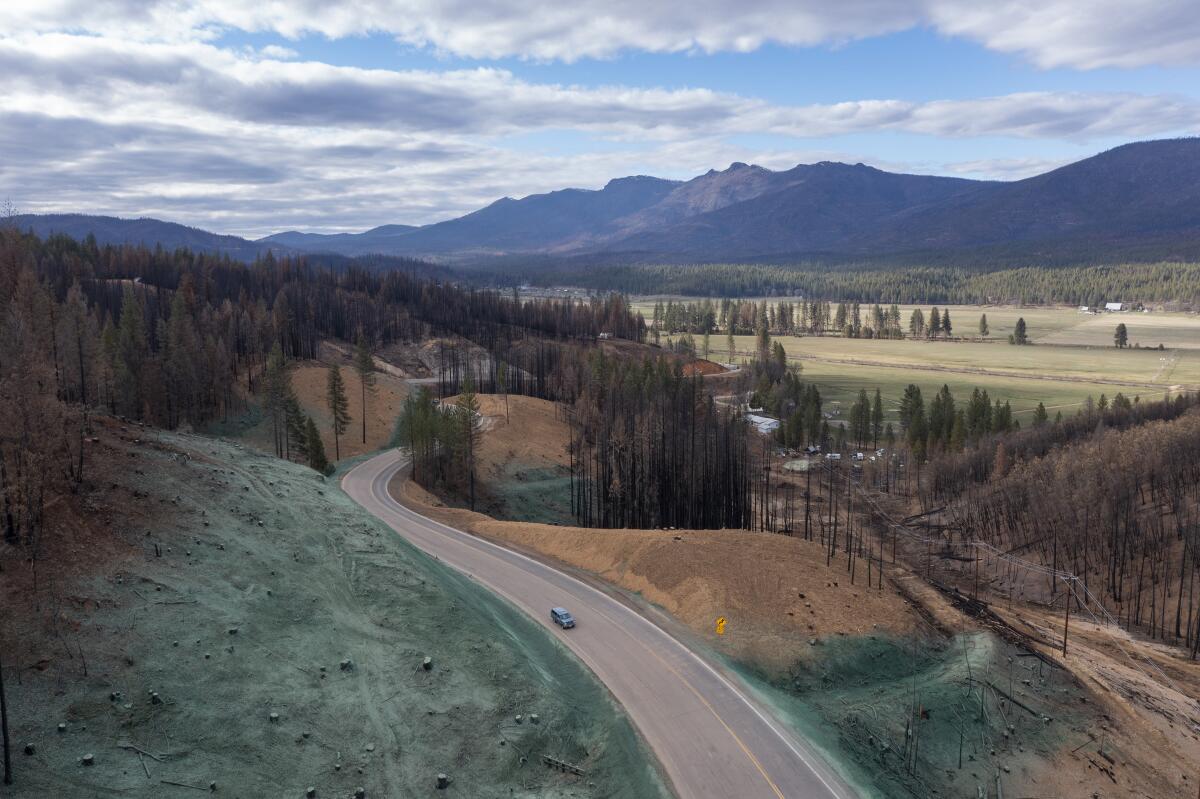
Researchers have found that some California forests aren’t bouncing back the way they should after intense wildfires. My Times colleague Alex Wigglesworth reported on how a burn scar in Northern California is filled with bare tree carcasses, and how the altered landscape offers a glimpse of what forests across the Sierra Nevada could become. Jon Wang, a researcher at UC Irvine and the study’s lead author, explained that because fires in recent years have been so massive, “the forests don’t have a chance to keep up or recover in time.” He described the trend as “an acceleration of the fire regime that is overwhelming these forests.”
Thankfully, the giant sequoias in Yosemite National Park’s Mariposa Grove are no longer threatened by the Washburn fire. Foresters and ecologists told Eric Westervelt of NPR that a half-century of intentional burning or ‘’prescribed fire’’ reduced the amount of vegetation ‘’fuel’’ in and near the grove, allowing the flames to pass through and leave the trees unscathed. As the fire was raging nearby, crews turned on sprinklers to protect the sequoias. But Char Miller, a professor of environmental history at Pomona College, argues that installing sprinklers to protect sequoias doesn’t make sense at a time when the National Park Service and other agencies must make “judicious, long-term decisions about how to respond to the powerful impact that climate change is having on the landscapes they manage.” As Miller put it in an op-ed piece for The Times, “We cannot irrigate our way out of climate change.”
For some of California’s wildland firefighters, low pay and low morale are taking a toll. Alex Wigglesworth has written extensively for The Times about how low wages and rising housing costs have left the Forest Service struggling to recruit and retain employees in California. She joined fellow reporters Rong-Gong Lin II and Rosanna Xia this week on the The Times podcast to talk about burnout on the front lines of disasters. They also talked about climate grief, and reaching for hope. And they shared some witty jokes too. Give it a listen.
ONE MORE THING
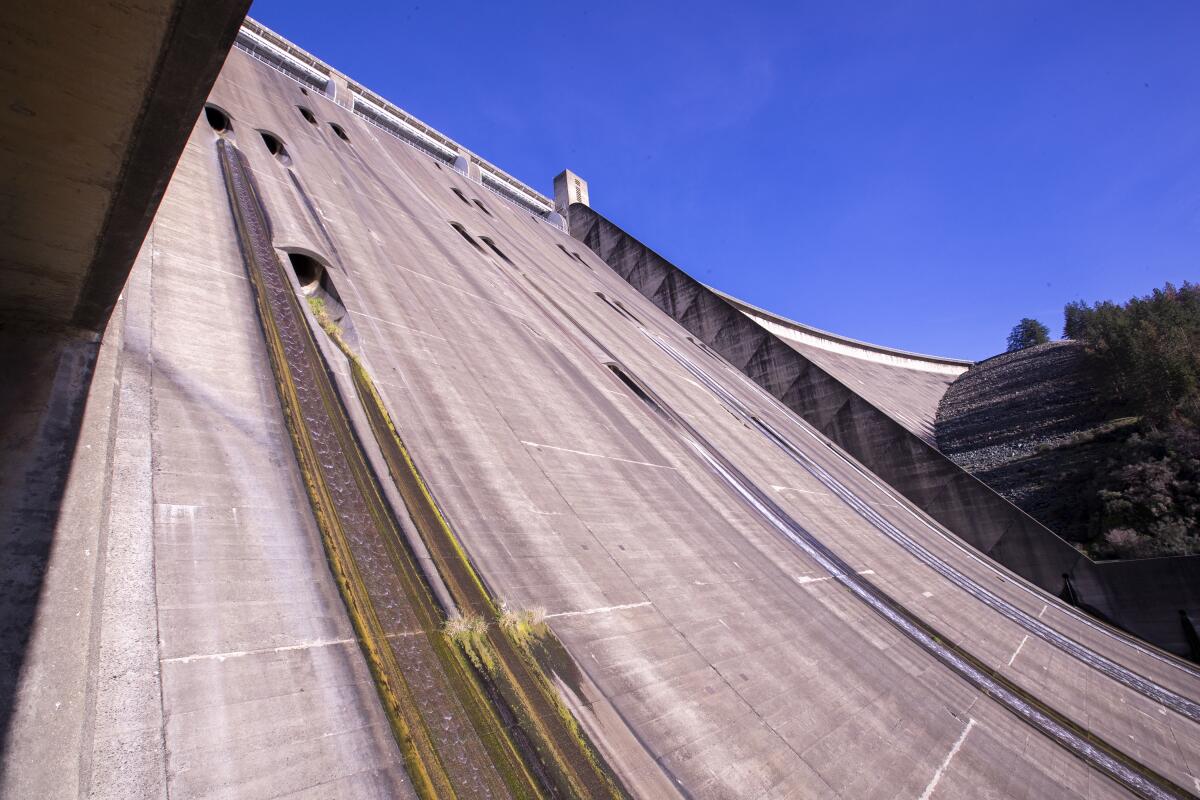
Earlier this year, I visited a fish hatchery at the base of Shasta Dam where federal biologists raise endangered winter-run Chinook salmon.
Since the 1940s, the dam has blocked salmon from returning to the cold waters of the McCloud River near Mt. Shasta, where they once spawned. And the fish have increasingly struggled as the water flowing from the dam has become so warm that it’s sometimes lethal for salmon eggs.
I talked with biologists about their plans to eventually truck fish above Shasta Dam and reintroduce them to the McCloud River. I also talked with Caleen Sisk, chief and spiritual leader of the Winnemem Wintu Tribe, about the tribe’s preference not to use hatchery-raised fish and to instead bring eggs from New Zealand, where the winter-run Chinook were transplanted more than a century ago.
At the time, the plans for returning salmon to the McCloud River seemed complicated and likely to take time. So I was surprised when I heard last week that state and federal officials were working with the tribe and bringing thousands of salmon eggs from the hatchery to the McCloud River.
Members of the tribe held a ceremony by the river as the eggs arrived in a cooler, and then helped move the eggs to incubation tanks filled with water from the McCloud, which the tribe calls Winnemem Waywacket.
Although the eggs and young salmon still face many hurdles, Sisk said, “It’s a glimmer of hope.”
Soon, when the eggs hatch and the tiny salmon emerge, they will swim in their ancestral river for the first time in 80 years.
We’ll be back in your inbox next week. If you enjoyed this newsletter, please consider forwarding it to your friends and colleagues.




